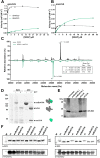Reengineering the specificity of the highly selective Clostridium botulinum protease via directed evolution
- PMID: 35705606
- PMCID: PMC9200782
- DOI: 10.1038/s41598-022-13617-z
Reengineering the specificity of the highly selective Clostridium botulinum protease via directed evolution
Abstract
The botulinum neurotoxin serotype A (BoNT/A) cuts a single peptide bond in SNAP25, an activity used to treat a wide range of diseases. Reengineering the substrate specificity of BoNT/A's protease domain (LC/A) could expand its therapeutic applications; however, LC/A's extended substrate recognition (≈ 60 residues) challenges conventional approaches. We report a directed evolution method for retargeting LC/A and retaining its exquisite specificity. The resultant eight-mutation LC/A (omLC/A) has improved cleavage specificity and catalytic efficiency (1300- and 120-fold, respectively) for SNAP23 versus SNAP25 compared to a previously reported LC/A variant. Importantly, the BoNT/A holotoxin equipped with omLC/A retains its ability to form full-length holotoxin, infiltrate neurons, and cleave SNAP23. The identification of substrate control loops outside BoNT/A's active site could guide the design of improved BoNT proteases and inhibitors.
© 2022. The Author(s).
Conflict of interest statement
L.Q.L., S.L., K.B.-C., S.Z.M., E.J.V.-C., D.C.R., B.P.S.J., L.E.S., and A.D.B.-A. are full-time employees of AbbVie and receive salary and/or stocks/stock options as compensation. G.A.W., A.D.B.-A., R.P.D., L.E.S., L.Q.L., G.S., D.C.R., B.P.S.J., M.H.F., and S.M. are inventors on a related provisional patent application. All other authors declare that they have no competing interests.
Figures




References
Publication types
MeSH terms
Substances
Grants and funding
LinkOut - more resources
Full Text Sources
Medical
Research Materials

